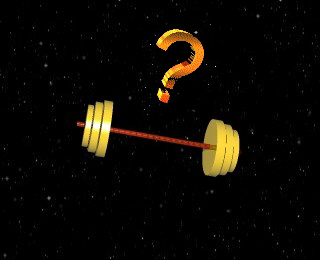When G stops being a constante...

The gravitational constant G
G is what physicians call a "fundamental
constante ", a value which doesn't change through time and through space.
Because of this value we can
know the strength of the gravitation, the force existing between two bodies
attracting each other.
If one body is the earth and
the other one an object, or a beeing, placed on the earth the name of this
force is...the weight!
The equation giving the value
of the force is: F =
-Gmm'
r 2
Where G= 6,672*10-11 N.m2.kg-2
m is the mass of the first
body , m' the mass of the second body. m may be the Earth's mass.
r is the distance between
the center of gravity of the two objects.
N means newtons - a unit
of force -, m meterss, kg kilograms.
When G stops being a constante...

Difference between weight and mass:
The mass of a body doesn't depend
on where is that body. An elephant or a dinosaur will always have the same
mass, never mind if he is on the Earth, on the Moon or anywhere in space.
But the weight of the animal depend on where is this animal. The weight
of an elephant is not the same on the Moon or on the Earth.
The weight depends on the value
of G too!
The weight of a elephant on
the Earth changes if you change the value of G.
In our hypothesis, the value
of G changed 65 millions years ago, the dinosaurs' weight - like other
animals weights - increased!
The size of the change of G.
We need more studies to know exactly the old value of G.
But we can try to make an estimation.
If the elephant is the heaviest
animal able to live, we must suppose the diplodocus had nearly the same
weight than an elephant, nearly 10 tons; so the gravity during the dinosaurs'
age should have been the third of todays gravity.
65 millions years ago, G, the
gravity, increased threefold!
G and the "missing mass" of
the universe!

For many years, astronoms are looking for the "missing mass" of the Universe. The meaning of this quest is simple: According to today's knowledge of Universe and gravity, Universe should...falls in pieces. We can't explain, for instance, why galaxies are stable. If me make the hypothesis tha G is not a constante, we can understand why the universe is stable without looking for a "missing mass" that nobody has never found!
G and the superstrings

The last theory explaining the
structure of the stuff of Universe is the toe ( theory of Everything ).
According to this theory, fundamental particle of universe are little strings,
vibrating like music tools ropes. According to the vibrations, we can see:
Neutrons, Protons etc...
What is important for us is... that theory allows sudden changes of the value of G!

In today's world you can observe
the trajectory of a moving object. If you send a rockett from the Earth
to the Moon, you'll see this rockett covering all the trajectory between
Earth and Moon.
In the quantum physics
world, rules are different.
An electron can "jump" between
two levels of energy without going into "intermediate" levels. If the two
levels of energy where Moon and Earth and the electron were a rockett,
you'd see the electron vanishing
from the sights on Earth and appearing on the Moon.
It sounds like magic. But it's
not magic, it's quantum physics.
We simply make here the hypothesis
that G jumps like a common electron!